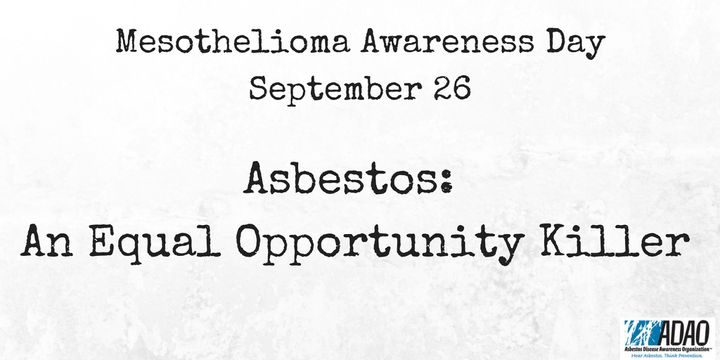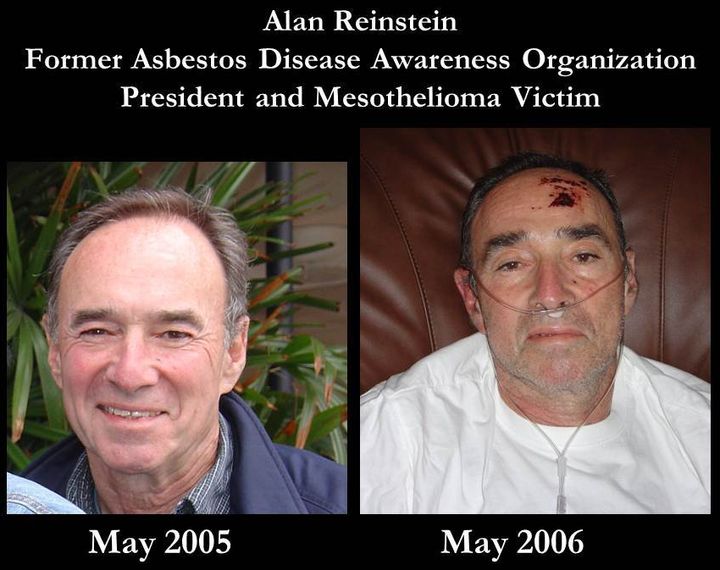
When most people hear “mesothelioma,” they probably think of late-night television commercials from lawyers advertising their services to the afflicted, but their knowledge of the disease and the corporate cover-up that lead to millions being exposed to asbestos often ends there. Even worse, most Americans don’t realize that weak chemical safety regulations and asbestos industry lobbying have created a man-made disaster with the potential to impact their own lives.
On September 26, Mesothelioma Awareness Day, asbestos victims around the world will stand shoulder to shoulder to raise awareness and demand action. We do this because we know first-hand the depths the asbestos industry will go to ensuring its product remains legal and lethal, and we have learned the painful way that when it comes to asbestos diseases, ignorance is not bliss and prevention is the only cure.
If I could tell people one thing about asbestos it would be to quickly disavow the notion that asbestos is a problem of the past. In fact, still to this day approximately 125 million people are exposed to asbestos at the workplace, according to the World Health Organization (WHO). Blue-collar occupational exposure is often thought of as the hallmark of asbestos diseases, but the risk extends far beyond factories and shipyards. Asbestos is ubiquitous and can be found in home, schools, workplaces, and consumer shelves though out the nation.
For decades, asbestos was widely used to create building materials such as flooring, roofing, shingles, and cement. When building materials are disturbed during disasters and fires they create a “deadly dust” that exposes people who work and live nearby and first responders called to the scene to asbestos. As this month’s heartbreaking 15th anniversary of 9/11 somberly reminds us, the “deadly dust” is all too prevalent.
The risk doesn’t stop at work, either. Secondary exposure has been increasingly linked to asbestos disease, as exposed workers come home with asbestos on their clothes and hug their family members, effectively passing along the contamination. Additionally, recent studies reveal that asbestos can be found in crayons and other children’s toys in both the United States and Australia, with the possibility of this hazard in other countries extremely likely.
As a result of these combined pathways of exposure, WHO estimates that more than 107,000 people lose their lives to asbestos diseases each year. A number that is far too high considering 100% of these deaths are preventable.
Mesothelioma 101
I will never forget the first time I heard the word “me· so· the· li· o· ma.” A doctor boldly pronounced this strange word as the diagnosis for my very sick husband, Alan. I first asked how to spell it since I had never even heard the term before. In case you’re as in the dark as I was that day 13 years ago, I’ll leave it to the Center for Disease Prevention and Control (CDC) to explain: “Mesothelioma is a rare form of cancer which is almost always caused by exposure to asbestos. This type of cancer happens when harmful, or malignant, cells develop in the protective lining that covers most of the body's internal organs”—most commonly in the chest and abdominal cavities.

While mesothelioma may be the cancer most commonly associated with asbestos exposure, it actually accounts for a small fraction of all asbestos caused diseases. Asbestos also causes lung, laryngeal, testicular, and ovarian cancers, as well as asbestosis, a non-cancerous fibrosis of the lungs. It’s important to note that if you’ve been exposed to asbestos, smoking tobacco greatly increases the risk of developing an asbestos caused disease—and the heavier the smoking, the higher the risk, according to WHO.
The latency period between exposure and emergence of symptoms with mesothelioma and other asbestos-caused diseases can be long—between 20-40 years, according to the CDC. This can make it difficult to pinpoint and prove the circumstances of exposure, and it can give victims of asbestos exposure a sense of “false hope” when it comes to their health, which can suddenly and drastically change almost seemingly overnight.
Like the tens of thousands families who face a diagnosis of an asbestos-related disease, I felt very alone when Alan’s battle began. The more I researched however, the more that feeling of emptiness and sadness transformed into anger. I learned that for more than a century our government has known the deadly effects of this tiny, lethal fiber, but legislation to prevent exposure, prevent future deaths and protect American public health was derailed by the asbestos industry.
Fatal Deception
The medical community and the U.S. government have known for nearly a century that asbestos exposure causes cancer and other chronic health issues, yet the U.S. continues to import hundreds of tons of raw asbestos annually—358 tons in 2015 alone, according the United States Geological Survey.
It’s not necessarily for lack of trying that asbestos hasn’t been banned. In 1989, the U.S. Environmental Protection Agency (EPA) tried to ban asbestos on the grounds that it posed unreasonable risk to human health, but because of weaknesses in the existing chemical safety laws, in 1991, the asbestos industry sued and overturned the EPA’s ban attempt.
My battle with asbestos began in 2003 and frankly, not much has changed—though that may not be true for much longer.
This summer, President Obama signed the Lautenberg Chemical Safety Act (LCSA) into law, effectively reforming the badly broken 1976 Toxic Substances Control Act (TSCA). President Obama used asbestos to explain why the reforms were needed: “…the system was so complex, so burdensome that our country hasn’t even been able to uphold a ban on asbestos –a known carcinogen that kills as many as 10,000 Americans every year. I think a lot of Americans would be shocked by that.”
The new law removes some obstacles from the old system that allowed corporate interests to supersede public health and the environment, empowering the EPA to finally follow through on the asbestos ban they tried to instate nearly 30 years ago. Under the new law, the EPA must begin by selecting 10 high-risk chemicals for evaluation by December 22, 2016 and then potential regulation. Undoubtedly, there is consensus and every major public health and environmental group agrees: Asbestos belongs at the top of this list.
My Story Could Become Your Story
More than 250,000 Americans have died from mesothelioma and other asbestos-caused diseases since the EPA’s attempted ban was overturned in 1991. While nothing can bring them back or take away the pain, these hundreds of thousands of victims—and the loved ones they left behind—are leading the way toward change.
The stories of asbestos victims have resonated throughout the ranks of our government, all the way up to the Oval Office, as evidenced by President Obama’s far-from-subtle mention of asbestos. Several U.S. Senators have written letters to the EPA, pressuring the prioritization of asbestos. Even some industry leaders are finally calling for a ban, realizing that they can’t properly protect their workers from the undue risk.
Change is absolutely on the horizon, but until a ban is in place, we must continue to speak up about asbestos—both to pressure the EPA to uphold its duty to protect public health and the environment, and to increase risk awareness so people can protect themselves. Mesothelioma Awareness is so much more than just a day on a calendar—it’s a mantra, and a lifesaving one at that.
Join me in sharing information about mesothelioma with your friends and family – especially those who may be at risk of exposure to asbestos and not even know it. Share this with the teachers who are educating our children in crumbling schools, parents who are worried about the ingredients in the toys their children’s’ toys, the first responders who put their lives on the line to save others, and the do-it-yourselfers who are renovating old homes.
As a mesothelioma widow and advocate, I know all too well the devastating effects of this disease. But I also know that there is strength in numbers. And where there is a community fueled by the desire to evoke change, there is hope for a future that someday knows no asbestos.
